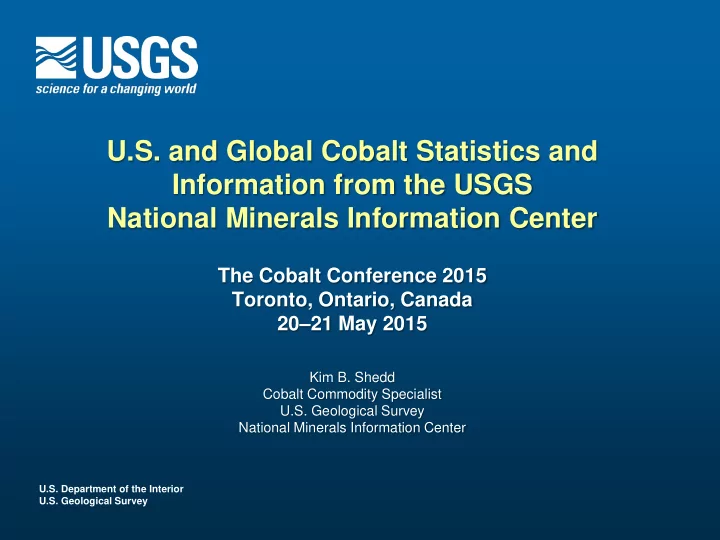

U.S. and Global Cobalt Statistics and Information from the USGS National Minerals Information Center The Cobalt Conference 2015 Toronto, Ontario, Canada 20–21 May 2015 Kim B. Shedd Cobalt Commodity Specialist U.S. Geological Survey National Minerals Information Center U.S. Department of the Interior U.S. Geological Survey
Overview USGS National Minerals Information Center U.S. cobalt supply & consumption Global cobalt resources & reserves Where to find more information
USGS National Minerals Information Center Mission: to collect, analyze, and disseminate information on the domestic and international supply of and demand for minerals and mineral materials essential to the U.S. economy and national security. Goal: to provide decisionmakers with the information required to ensure that the Nation has an adequate and dependable supply of minerals and materials to meet its defense and economic needs at acceptable costs related to environment, energy, and economics.
USGS National Minerals Information Center— Cobalt Statistics and Information Domestic Global Statistics Statistics Production Mine production Consumption Refinery production Imports & exports Refinery capacity Government, LME, and industry LME stocks stocks Reserves Prices Resources Examples of additional information Prices Legislation & Government Examples of additional information programs Country-by-country reviews of Status of U.S. operations and industry developments planned projects Status of planned projects Special reports on topics of Special reports on topics of interest interest
U.S. Cobalt Supply United States is 75–80% import reliant for cobalt. About one-quarter of reported cobalt consumption is derived from scrap. Prior to 2010, cobalt shipments from the National Defense Stockpile (NDS) contributed to supply. Some U.S. cobalt mine production in Michigan and Montana; potential future Sources: Defense Logistics Agency Strategic Materials, production in Minnesota and U.S. Census Bureau, and U.S. Geological Survey Idaho
U.S. Cobalt Supply—Imports Recent imports have been about 11,000 metric tons per year of cobalt. China, Finland, Norway, and Russia are leading suppliers. Sudden decrease in imports following global financial crisis and rapid return to pre-crisis levels China’s share increased during past decade. Source: U.S. Census Bureau Increase in imports from “Other” countries
U.S. Cobalt Supply—National Defense Stockpile (NDS) Managed by Defense Logistics Agency Strategic Materials Cobalt sales began in 1993; the authorization expired in 2011. Inventory as of December 31, 2014, was 301 metric tons of cobalt metal. Acquisition of lithium ion battery precursors during FY 2015–19 • 750 kilograms of lithium cobalt oxide (LCO) • 2,700 kilograms of lithium nickel cobalt aluminum oxide (NCA) Source: Defense Logistics Agency Strategic Materials
U.S. Cobalt Supply—Mine Production Cobalt capacity, Company Cobalt- First year of metric tons per Project Scope containing production year contained Location product cobalt Stillwater Mining Co. PGE mines, mills, 1996* Stillwater operation smelter, and Minimal Nickel sulfate Montana refinery Lundin Mining Corp. 2014 Nickel-copper mine 900 e Nickel Eagle Mine and mill concentrate Michigan PolyMet Mining Corp. Copper-nickel-PGE Nickel-PGE 2016 e NorthMet Phase 1 360 mine and mill concentrate Minnesota Formation Metals Inc. Cobalt sulfate Cobalt mine and NA 1,500 e Idaho Cobalt or cobalt mill and refinery Idaho cathode *Base Metals Refinery was commissioned in 1996. e Estimated. NA Not available. PGE platinum-group element.
U.S. Cobalt Consumption Reported consumption Based on voluntary surveys of U.S. cobalt processors and consumers Data include estimates for nonrespondents Data collected by material and end use Apparent consumption Calculated I mports - Exports + Secondary Production ± Changes in Government and Industry Stocks Can be used to evaluate total reported consumption
Global Cobalt Resources & Reserves Definitions Cobalt reserves by country Resource project overview Deposit types Resources, reserves, and production by deposit type
Resources & Reserves—Definitions Resource A concentration of naturally occurring solid, liquid, or gaseous material in or on the Earth’s crust in such form and amount that economic extraction of a commodity from the concentration is currently or potentially feasible. Reserve Demonstrated resource from which minerals can be Inferred Reserves Reserves extracted profitably with existing Inferred Marginal Reserves Marginal technology and under Reserves present economic Inferred conditions. Demonstrated Subeconomic Subeconomic Resources Resources Sources: USGS Mineral Commodity Summaries, Appendix C Principles of a resource/reserve classification for minerals, USGS Circular 831, 1980
Global Cobalt Reserves—By Country Published annually 7.2 Mt Sourced mainly from company and Government reports Mt = Million metric tons
Global Cobalt Resources Unpublished data from report in preparation as Slack, J.F., Kimball, B.E., and Shedd, K.B., Cobalt, chap. F of Schulz, K.J., Bradley, D.C., DeYoung, J.H., Jr., and Seal, R.R., II, eds., Critical mineral resources of the United States—Economic and environmental geology and prospects for future supply: U.S. Geological Survey Professional Paper 1802 (in preparation) Data for 215 individual deposits or districts Compiled from industry, government, and academic sources Data for conventional identified resources Resources categorized by deposit type Total terrestrial identified cobalt resources were 25.5 Mt, very similar to 26.1 Mt independently derived by Mudd, G.M., Weng, Z., Jowitt, S.M., Turnbull, I.D., and Graedel, T.E., 2013, Quantifying the recoverable resources of by-product metals—The case of cobalt: Ore Geology Reviews, v. 55, p. 87–98.
Global Cobalt Resources—Deposit Types Principal terrestrial deposits Seafloor deposits Sediment-hosted stratiform copper-cobalt Iron-manganese(-nickel-copper-cobalt-molybdenum) nodules Magmatic nickel-copper(-cobalt-platinum- group element) sulfide Iron-manganese(-cobalt-molybdenum-rare earth element) crusts Nickel-cobalt laterite Copper(-zinc-cobalt-silver-gold) volcanogenic massive sulfide Other terrestrial deposits Black-shale-hosted nickel-copper-zinc-cobalt Iron oxide-copper-gold(-silver-uranium-rare earth element-cobalt-nickel) Metasedimentary rock-hosted cobalt-copper- gold Volcanogenic copper(-zinc-cobalt-silver-gold) massive sulfide Mississippi Valley-Type zinc-lead(-cobalt- nickel) sulfide Iron-copper-cobalt skarn and replacement Polymetallic (silver-nickel-cobalt-arsenic- bismuth) and other cobalt-rich vein
Global Cobalt Resources—By Deposit Type 147 Mt cobalt 25.5 Mt cobalt Mt = million metric tons
Global Cobalt Resources, Reserves, and Mine Production—By Deposit Type Resources Reserves (2011) Mine Production (2011) 25.5 Mt cobalt 7.5 Mt cobalt 0.109 Mt cobalt Mt = million metric tons
Additional Cobalt Information from the National Minerals Information Center URL for Cobalt Statistics and Information http://minerals.usgs.gov/minerals/pubs/commodity/cobalt/ URL for List Services http://minerals.usgs.gov/minerals/pubs/listservices.html URL for RSS feed http://feeds.feedburner.com/usgs_mpubs Annual reports Mineral Commodity Summaries Minerals Yearbook Monthly reports Mineral Industry Surveys Special reports and products Data Series 140—Database of key statistics (1900–2012) Metal Prices in the United States through 2010, Scientific Investigations Report 2012–5188 Reports on materials flow and recycling Reports on mineral resources
Recommend
More recommend